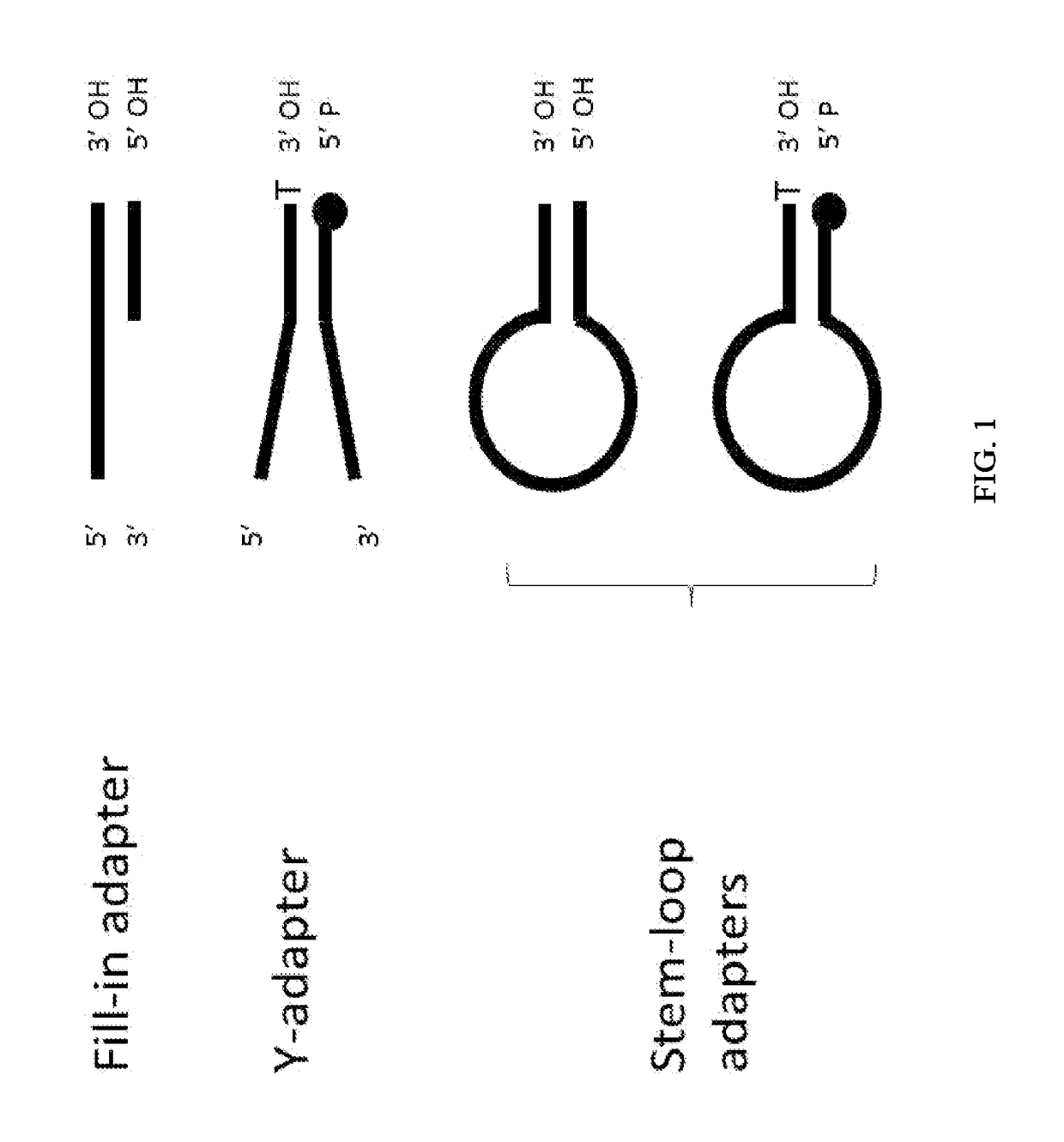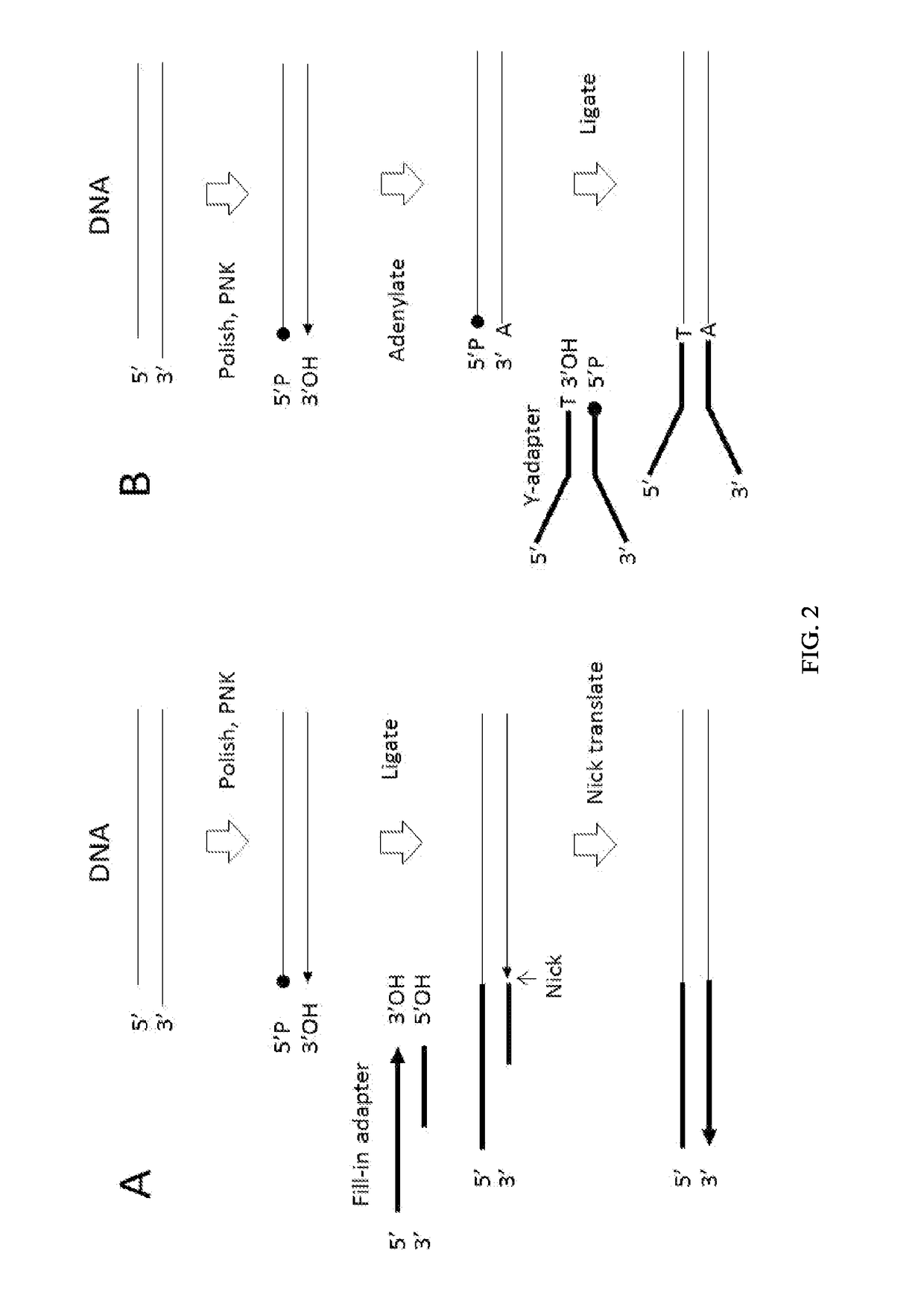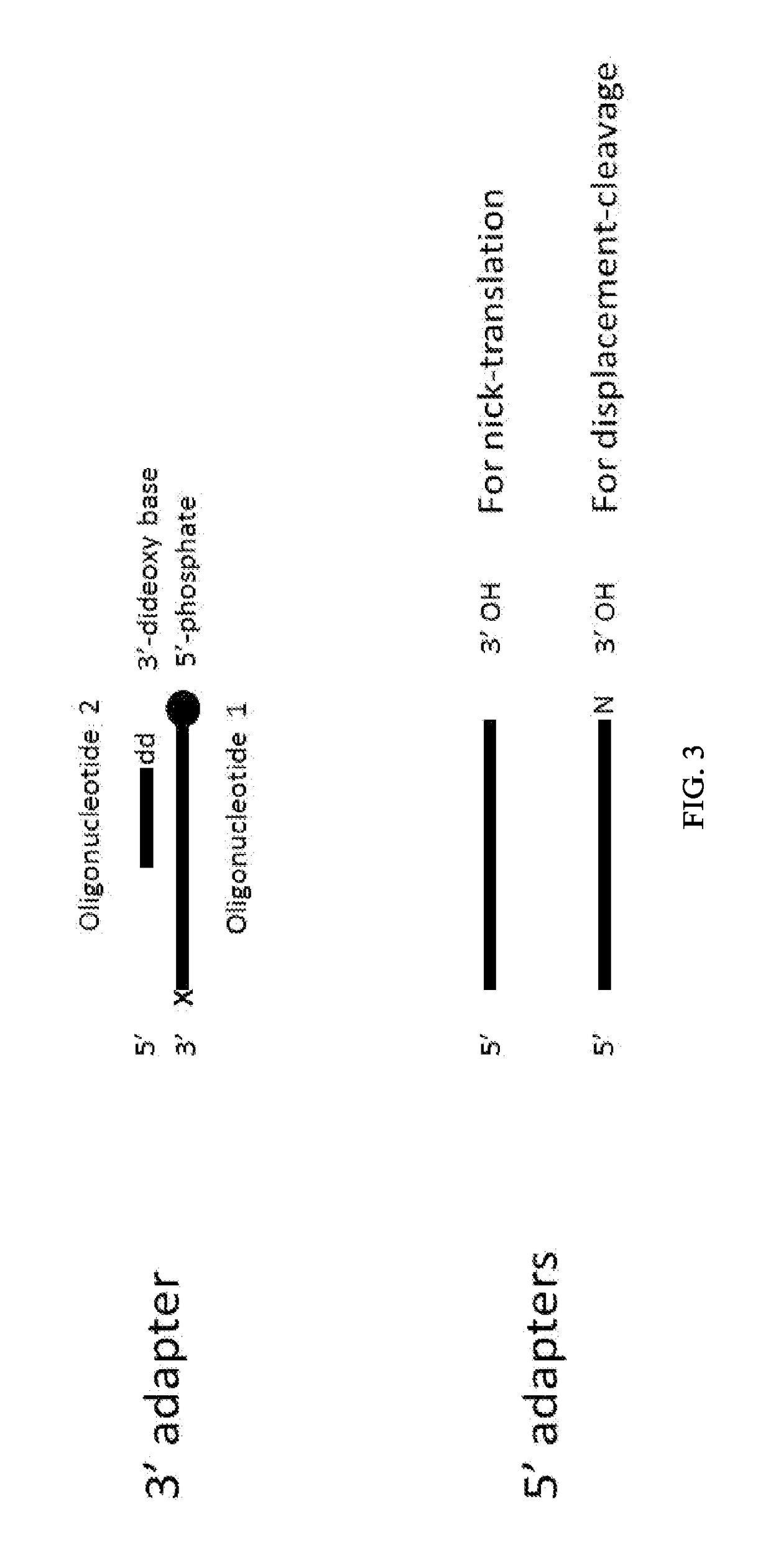Enhanced Adaptor Ligation
a technology of adaptors and adaptors, applied in the field of enhanced adaptor ligation, can solve the problems of difficult control of enzymatic reaction, introducing representation bias, and predictable length of fragments, and achieve the effect of increasing binding stability and increasing binding stability
- Summary
- Abstract
- Description
- Claims
- Application Information
AI Technical Summary
Benefits of technology
Problems solved by technology
Method used
Image
Examples
example 1
Comparison of Conventional Adapter Ligation to 3′ Adapter Ligation with FAM-Labeled Oligonucleotides
[0277]Rationale:
[0278]Using a FAM-labeled oligonucleotide system, blunt ligation using fill-in adapters (FIG. 2A) or 3′ adapters (FIG. 3) was tested at different molar ratios of substrate to adapter to examine the effect on ligation efficiency and chimera formation.
[0279]Materials:[0280]Fill-in adapter contains oligonucleotides 12-900 and 13-426 (Table 1)[0281]3′Adapter; 1st oligonucleotide 13-340 (Table 1)[0282]3′Adapter; 2nd oligonucleotide option 1 (with a blocking 3′ deoxythymidine base at the 3′ terminus) 13-559 (Table 1)[0283]3′Adapter; 2nd oligonucleotide option 2 (a phosphate group at the 3′ terminus) 13-558 (Table 1)[0284]FAM substrate A composed of oligonucleotides 13-562 and 13-563, where the FAM group labels ligation to the 5′ Phosphate of the substrate (Table 1)[0285]FAM substrate B composed of oligonucleotides 13-561 and 13-564, where the FAM group labels ligation to the...
example 2
Comparison of Conventional Adapter Ligation to 3′ Adapter Ligation with Sheared, Size-Selected Genomic DNA
[0298]Rationale:
[0299]This experiment was performed to test the effect of polishing of physically sheared genomic DNA on the efficiency of conventional or 3′ adapter ligation
[0300]Materials:[0301]Fill-in adapter contains oligonucleotides 13-489 and 13-426 (Table 1)[0302]3′Adapter; 1st oligonucleotide 13-340 (Table 1) and 2nd oligonucleotide option 1 (containing a blocking3′ deoxythymidine base at the 3′ terminus) 13-559 (Table 1)[0303]NEBuffer 2 (New England Biolabs, cat#B7002S)[0304]100 mM 2′-deoxynucleoside 5′-triphosphate (dNTP) Set, PCR Grade (Invitrogen (Life technologies), cat#10297-018)[0305]Adenosine 5′-Triphosphate (ATP) (New England Biolabs, cat# P0756S)[0306]DNA Polymerase I, Large (Klenow) Fragment (New England Biolabs, cat#M0210S)[0307]T4 DNA polymerase (New England Biolabs, cat# M0203S)[0308]T4 Polynucleotide Kinase (New England Biolabs, cat# M0201S)[0309]Exonuclea...
example 3
Temperature Optimization for 5′ Adapter Ligation Using a FAM-Labeled Oligonucleotide Substrate
[0327]Rationale:
[0328]This experiment assessed the temperature dependence and dNTP composition on nick translation mediated 5′ adapter ligation.
[0329]Materials:[0330]5′ adapter oligonucleotide for nick-translation (13-144) (Table 1)[0331]FAM oligonucleotide substrate (13-581) (Table 1)[0332]Oligonucleotide template (13-582) (Table 1)[0333]100 mM 2′-deoxynucleoside 5′-triphosphate (dNTP) Set, PCR Grade (Invitrogen (Life technologies), cat#10297-018)[0334]E. coli DNA ligase (New England BioLabs, cat# M0205S)[0335]10×E. coli DNA Ligase Reaction Buffer (New England BioLabs)[0336]Taq DNA polymerase, concentrated 25 U / ul (Genscript, cat# E00012)[0337]25 bp ladder DNA size marker (Invitrogen (Life technologies), cat#10488-022)
[0338]Method:
[0339]A first set of nick translation reactions was assembled in a total volume of 301, comprising a final concentration of 1×E. coli DNA ligase Buffer, 30 pmole...
PUM
| Property | Measurement | Unit |
|---|---|---|
| temperatures | aaaaa | aaaaa |
| temperatures | aaaaa | aaaaa |
| temperature | aaaaa | aaaaa |
Abstract
Description
Claims
Application Information
 Login to View More
Login to View More - R&D
- Intellectual Property
- Life Sciences
- Materials
- Tech Scout
- Unparalleled Data Quality
- Higher Quality Content
- 60% Fewer Hallucinations
Browse by: Latest US Patents, China's latest patents, Technical Efficacy Thesaurus, Application Domain, Technology Topic, Popular Technical Reports.
© 2025 PatSnap. All rights reserved.Legal|Privacy policy|Modern Slavery Act Transparency Statement|Sitemap|About US| Contact US: help@patsnap.com



